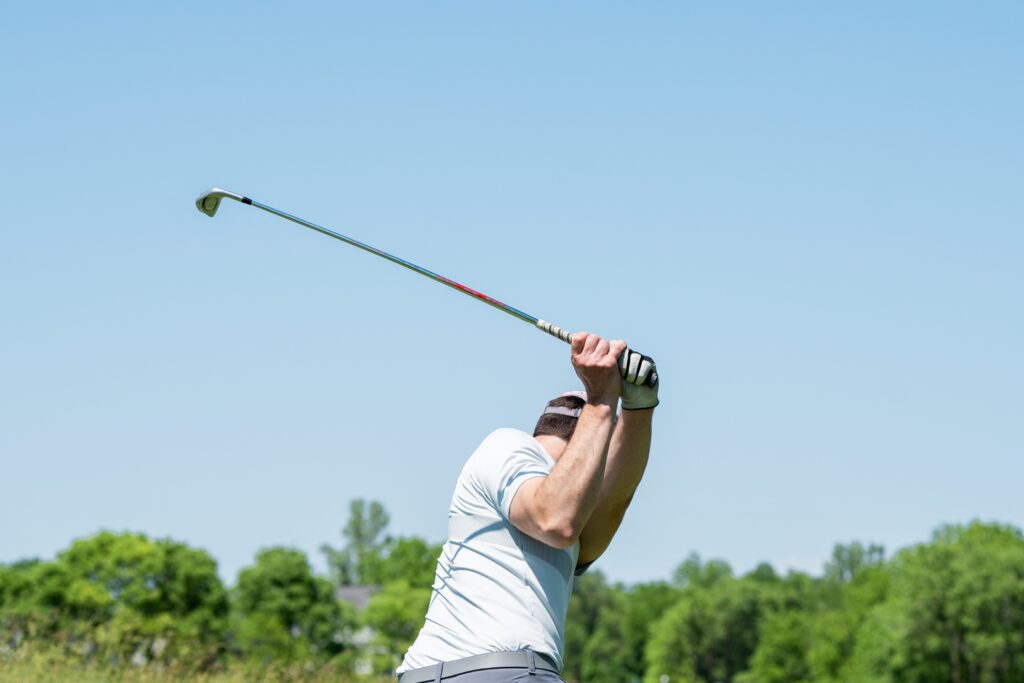Shoulder mobility plays a crucial role in achieving optimal performance in golf. As golfers, we often focus on developing our swing technique, strength, and flexibility, but we must not overlook the importance of shoulder mobility. The shoulders are involved in nearly every aspect of the golf swing, from the backswing to the follow-through.
In this blog, we will explore the significance of shoulder mobility in golf performance and how it can impact various aspects of your game. We will delve into the anatomy and function of the shoulder joint, highlighting the specific movements and functions that are essential for a successful swing. Additionally, we will discuss the common issues and limitations golfers may face with restricted shoulder mobility and how they can affect swing mechanics, consistency, and distance.
Summary
Shoulder Movement for Golf
The shoulder joint, also known as the glenohumeral joint, is a complex and highly mobile joint that allows for a wide range of motion. It is formed by the articulation of the humerus (upper arm bone) with the scapula (shoulder blade). The shoulders play a critical role in the golf swing, contributing to various movements that are essential for a successful and efficient swing. Understanding these shoulder movements can help golfers optimize their technique and performance. Here’s a breakdown of the key shoulder movements involved in the golf swing:
Shoulder Movement for Golf
- Shoulder Rotation: Shoulder rotation is a primary movement in the golf swing. During the backswing, the lead shoulder (left shoulder for right-handed golfers) undergoes external rotation, while the trail shoulder (right shoulder for right-handed golfers) experiences internal rotation. This rotational movement allows for the proper positioning and alignment of the arms and club.
- Shoulder Flexion and Extension: Shoulder flexion and extension refer to the upward and downward movements of the arms during the swing. During the backswing, the lead shoulder undergoes flexion, raising the arms and club to achieve a high backswing position. On the downswing and follow-through, shoulder extension occurs, extending the lead arm forward and upward, generating power and clubhead speed.
- Scapular Movement: Although not strictly a shoulder movement, the movement of the scapulae (shoulder blades) is closely connected to shoulder function. The scapulae play a role in maintaining stability and proper positioning of the shoulders throughout the swing. Proper scapular movement involves controlled protraction (forward movement) and retraction (backward movement) to facilitate optimal arm and shoulder alignment.
It is important for golfers to develop proper shoulder mobility and flexibility to execute these movements effectively. Regular stretching exercises and targeted mobility drills can help improve shoulder range of motion, allowing for a more fluid and powerful golf swing. By understanding and actively working on these shoulder movements, golfers can enhance their swing mechanics, generate more power, and achieve greater consistency in their game.
Common Shoulder Issues with Golf ⛳️
Golfers frequently encounter various issues related to shoulder mobility, which can significantly impact their swing mechanics, power generation, and overall performance. Here are some common problems golfers face concerning shoulder mobility:
- Limited External Rotation: Limited external rotation in the lead shoulder (left shoulder for right-handed golfers) can restrict the backswing and hinder the ability to achieve an optimal swing plane. It can result in a narrower swing arc, reduced shoulder turn, and potential compensations, such as lifting the club too steeply or an overactive upper body.
- Restricted Internal Rotation: Restricted internal rotation in the trail shoulder (right shoulder for right-handed golfers) can impede the downswing and follow-through, limiting the ability to rotate the shoulders through impact. This limitation may lead to compensatory movements, such as an early release or an over-reliance on the arms rather than engaging the body rotation.
- Decreased Shoulder Flexion: Insufficient shoulder flexion can restrict the backswing, preventing the lead arm from achieving the desired high position at the top. Golfers with limited shoulder flexion may struggle to generate enough clubhead speed and may experience difficulty in maintaining proper club positioning during the swing.
- Scapula Stability: Stable scapulae are crucial for maintaining proper shoulder mechanics and optimizing shoulder mobility in the golf swing. By ensuring proper scapular positioning and controlled movements, golfers can enhance stability, power transfer, and efficiency in their swings. Stable scapulae serve as a foundation for optimal shoulder movement, allowing for smooth coordination between the upper body and club. They provide a solid base for power generation and help distribute forces evenly, reducing the risk of shoulder injuries. By focusing on scapular strengthening exercises, such as scapular retractions and serratus anterior exercises, golfers can improve scapula stability and enhance their overall golf performance. Developing good body awareness, posture, and swing mechanics further contribute to optimal scapula stability during the golf swing. Consulting with a golf professional or physical therapist can provide personalized guidance and exercises to improve scapula stability specific to individual needs and goals.
- Lack of Thoracic Spine Mobility: Limited mobility in the thoracic spine (upper back) can restrict proper shoulder rotation and affect the overall range of motion in the golf swing. Insufficient thoracic spine mobility can force the shoulders to compensate for the lack of rotation, leading to swing faults and decreased power.
Benefits of Shoulder
Mobility for Golf
Improving shoulder mobility can have numerous positive effects on golf performance and overall well-being. Here are some key benefits of enhancing shoulder mobility:
- Increased Range of Motion: Improved shoulder mobility allows for a greater range of motion in the golf swing. It enables a more complete backswing, optimal club positioning, and a smoother follow-through, leading to improved swing mechanics and greater shot versatility.
- Greater Power Generation: Adequate shoulder mobility facilitates efficient power generation in the golf swing. It enables proper sequencing and transfer of energy from the lower body to the upper body, leading to increased clubhead speed and greater distance off the tee.
- Reduced Risk of Injuries: Optimal shoulder mobility helps minimize the risk of shoulder injuries in golf. Improved mobility reduces stress and strain on the shoulder joint, muscles, and tendons, decreasing the likelihood of overuse injuries and promoting overall joint health.
- Improved Posture and Alignment: Enhancing shoulder mobility contributes to better overall posture and alignment throughout the swing. It aids in maintaining a neutral spine, balanced weight distribution, and proper shoulder position, reducing the risk of swing faults and promoting a more efficient and effective swing.
- Enhanced Comfort and Freedom of Movement: Increasing shoulder mobility leads to improved comfort and freedom of movement during the swing. Golfers with improved shoulder mobility experience less tension, stiffness, and restrictions, allowing for a more natural and fluid swing motion.
- Better Overall Functionality: Shoulder mobility extends beyond golf performance and positively impacts daily activities. Improved shoulder mobility enhances upper body movements, such as reaching, lifting, and carrying, promoting better overall functionality and reducing the risk of shoulder-related limitations or discomfort in daily life.
By prioritizing exercises, stretches, and mobility drills that target shoulder mobility, golfers can reap these benefits and unlock their full potential on the course. It is important to consult with a golf professional or physical therapist to develop a tailored plan that addresses individual limitations and goals, ensuring safe and effective improvement in shoulder mobility.
Summary:
Improving shoulder mobility brings a range of benefits that enhance golf performance and overall well-being. By increasing shoulder range of motion, golfers can achieve a more complete backswing, optimal club positioning, and a smoother follow-through, resulting in improved swing mechanics and shot versatility. Enhanced shoulder mobility also leads to better control and precision in club movements, allowing for more accurate ball striking and increased shot consistency.
Additionally, improved shoulder mobility facilitates efficient power generation, translating to higher clubhead speeds and greater distance off the tee. By reducing stress and strain on the shoulder joint, muscles, and tendons, optimal shoulder mobility lowers the risk of injuries and promotes joint health. Better posture, alignment, comfort, and freedom of movement during the swing are additional benefits of enhanced shoulder mobility.
Furthermore, improved shoulder mobility extends beyond golf, positively impacting daily activities and promoting better overall functionality. By prioritizing targeted exercises, stretches, and mobility drills, golfers can unlock the full potential of their shoulders and elevate their performance on the course.
Consulting with a golf professional or physical therapist ensures a tailored approach for safe and effective improvement in shoulder mobility.
Share to:
Now that you’ve learned about the importance of shoulder mobility in golf, it’s time to take action and elevate your game to new heights.
Speak to a PT Today
Wondering if Physical Therapy can help you? Call today to see if we can help!
Speak to A PT
RECENT ARTICLES:









